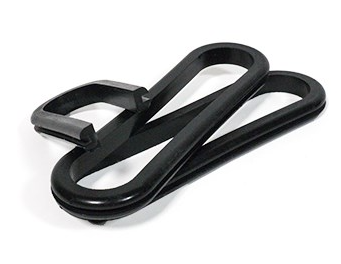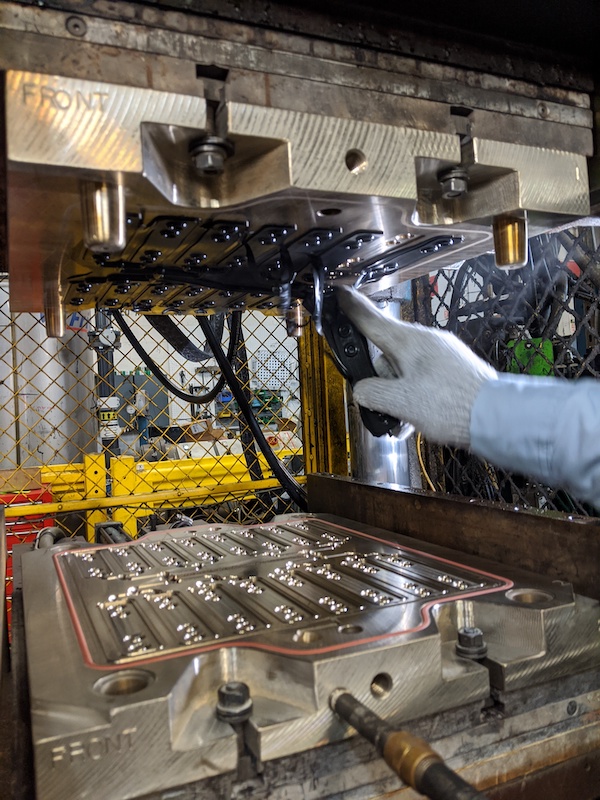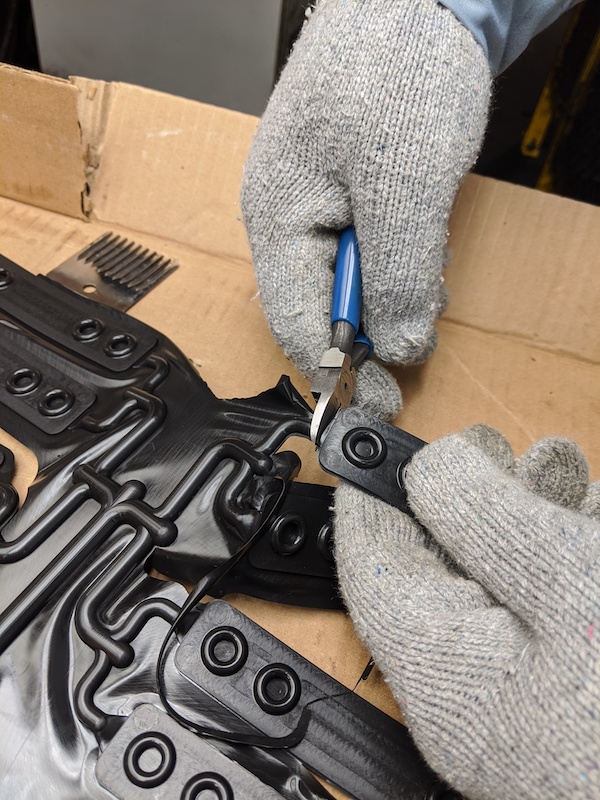Working Temperature Range:
High: 300°F / 149°C
Low: -60°F / -51°C
What is EPDM Rubber?

Ethylene propylene diene monomer, or EPDM for short, is one of the commonly used polymers in the rubber molding industry. It is the ideal choice for any product that requires general ozone, chemical and weather resistance. EPDM has good resistance to alcohols, greases, detergents, ketones, silicone oils, and mild acids. It’s also a fairly cost effective material.
These characteristics have contributed to EPDM Rubber’s reputation as one of the most basic and cost-effective materials options. If a product needs to be made from rubber, many manufacturers start with EPDM. EPDM is one of many types of synthetic rubbers. We've published an article explaining the differences between natural and synthetic rubber here.
If EPDM is the right material for your application, give Custom Rubber a call. Even if you aren’t sure, our team of experts can point you in the right direction. Click here to Contact Custom Rubber Corp. for answers to your EPDM rubber questions.
Discover More Engaging Content and Exclusive Insights by Clicking Here to Explore our YouTube Channel
Advantages of EPDM Rubber | The Pros of Working with EPDM
EPDM is a great general purpose rubber because of it's excellent weather resistance properties. It's versatile, strong, cheap and easy to work with. One of the main advantages of EPDM rubber is its excellent weather resistance. Its advantages also include:
- Excellent resistance to ozone
- Excellent resistance to sunlight
- Good low-temperature flexibility
- Resistance to water and detergents
- Resistance to greases
- Resistance to mild acids and silicone oils
- Easy to process
- Relatively low cost
- Common and readily available
Disadvantages of EPDM Rubber | The Cons of Working with EPDM
Unfortunately, EPDM rubber soaks oils and can fall apart when used for certain applications. While it is excellent in its resistance to outdoor elements, the main disadvantages of EPDM lay in its resistance to other common materials. Disadvantages of EPDM rubber include:
- Poor resistance to petroleum oils and fuel
- Poor resistance to mineral oils
- Poor resistance to petroleum-based lubricants
- Some limits on temperature range
- Weaker tear strength in comparison to natural rubber
- Poor abrasion resistance
Misconceptions about EPDM | Commonly Asked Questions about EPDM
The following questions regarding EPDM Rubber applications, properties and uses are frequently asked by our customers. Custom Rubber is here to provide answers and assist in your decision making process.
Q: What is EPDM Rubber used for?
A: EPDM Rubber is most commonly used in environments where ozone resistance is important, mainly outdoor applications. If your product is used in the sun, EPDM rubber is an ideal choice of material. Common applications of EPDM rubber include:
- Weather stripping for cars
- O-rings
- Conveyor belts
- Water-proofing sheets
- Hoses
- Gaskets
- Roller covers
- Wire insulation
EPDM rubber should not be used for working temperatures outside the 300°F / 149°C to -60°F / -51°C range. It should not be used for products that must be rain resistant or exposed to oil or gas.
Q: Are there different types of EPDM?
There are hundreds of thousands of different types of formulas that are simply referred to as “EDPM” despite slightly different makeups. The main qualification is that each one is based on an EPDM polymer that is then mixed with additives, cured or changed in some other way. Common ingredients added to EPDM polymers include carbon black or light fillers, antioxidants, processing aids, zinc oxide, petroleum-based plasticizers and curing materials.
With EPDM, the catalyst for vulcanization is usually sulfur. Peroxide-cured EPDM is also available, which increases the material’s working temperature range, but is generally more expensive. Sulfur-cured EPDM is generally cheaper, more common and easier to process.

Q: How long does EPDM rubber last?
A: EPDM rubber lasts longer than most other polymers and elastomers when exposed to sunlight, ozone and other weather conditions, but specific estimates depend on the environment in which it will stay. An EPDM part that is constantly exposed to sunlight and ozone generally lasts 15 to 20 years. But a grommet or small part enclosed indoors in a cabinet can last for decades, up to 40 years, before it may need replacement.
Q: How strong is EPDM?
A: EPDM’s strength depends on the formulation, which depends on the application of the product. There are two major ways that strength is measured in most rubber formulas. One is tensile strength, or the amount of pressure it takes to stretch the rubber until it breaks. The other is elongation, or how far it will stretch until it breaks. Generally speaking in terms of EPDM rubber, these measurements are trade offs. Raising the tensile strength means elongation is lowered and vice versa.
This comes into play especially with objects like tie down straps, which are often found outdoors. Natural rubber will break after six months or so in the sun, but EPDM generally lasts longer due to its outdoor resistance properties. However, strength also depends on the geometry of the product. For example, a strap used to hold down the antennae in a humvee may seem strong, but can break due to a failing strain point if not designed properly. Similarly, a part under constant dynamic force may not last more than one year. The product must be designed and used in a way that optimizes both types of strength for the given application.
Q: How do you bond EPDM rubber to metal?
A: Bonding EPDM rubber to metal is no different than bonding other types of rubber. There are three kinds of bonds used to join rubber to another material:
- Mechanical encapsulation: This is the most cost effective type of bonding where rubber is formed over most of the metal to encapsulate it and join the two together. Once completed, the only way to break the bond is to cut the rubber.
- Chemical bonding: This method involves applying a heat activated adhesive to the metal, putting it into the mold with rubber and allowing a chemical reaction to take place that bonds the two substrates together.
- Glue: Tried and true, this simple method involves taking the rubber and metal pieces, putting a very strong glue on both and sticking them together.
Q: Is EPDM rubber waterproof?
A: EPDM is an excellent choice for components or parts that will be exposed to weather - including rain. When EPDM is submersed in water for an extended time, it will swell slightly, usually less than 5%. This means it isn't necessarily "waterproof", but works well in applications where it's not permanently submersed.
Q: Can EPDM be heat welded?
A: No, EPDM rubber cannot be heat welded. If you attempt to melt EPDM, it will either remain stagnant with no change or it will begin to burn. EPDM can be formulated with additives to prevent it from burning, but general commercial-grade EPDM will burn if enough heat is applied.
Q: Is EPDM food grade rubber?
A: As we have emphasized, EPDM’s properties depend on its makeup. EPDM can be food grade if you are selective in your ingredients and formulation. Generally speaking, peroxide-cured EPDM is the best choice for food and beverage applications. We invite you to work with Custom Rubber Corp.’s experienced team closely to ensure the material you intend to use is considered food grade.

Q: How is EPDM used for gaskets?
A: EPDM rubber is a common material for use in creating gaskets. Not only does it mold well, it is also the least expensive option for most applications. Custom Rubber Corp. specializes in molding gaskets.
More Information on EPDM Rubber
Is EPDM rubber the right material for your product? Contact Custom Rubber Corp. and our team of experts can confirm you are headed in the right direction or point you to a better option. Click here to get in touch with Custom Rubber Co
How Does EPDM Rubber Compare:
| MATERIAL |
ABBREVIATION |
VIBRATION
ISOLATION |
RELATIVE PRICE |
TEMPERATURE RANGE |
OZONE, UV RESISTANCE |
OIL RESISTANCE |
| Natural |
NR |
Excellent |
Good |
-60F to 220F |
Poor |
Poor |
| Butyl |
IIR |
Excellent |
Fair |
-75F to 250F |
Good |
Poor |
| Ethylene-Propylene |
EPDM |
Good |
Excellent |
-70F to 250F |
Excellent |
Poor |
| Nitrile |
NBR |
Good |
Good |
-30F to 250F |
Poor |
Excellent |
| Neoprene / Chloroprene |
CR |
Excellent |
Excellent |
-60F to 220F |
Good |
Fair |
| Silicone |
VMQ |
Good |
Fair |
-175F to 450F |
Excellent |
Fair |
Other Rubber Materials We Specialize In: